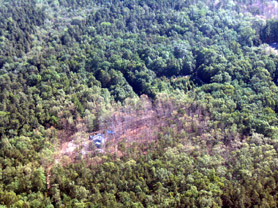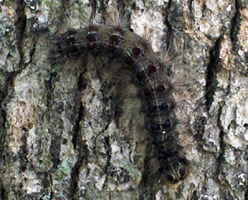Contact: Lynne Richmond (609) 292-8896
(TRENTON) – More than 125,000 acres of trees were defoliated by gypsy moths this past spring, the highest amount since 2001.
Two drier than normal spring seasons in a row kept a beneficial fungus disease dependent on moisture from naturally killing off the gypsy moth caterpillars. The fungus, Entomaphaga maimaiga, has helped New Jersey officials control the gypsy moth population in recent years.
“We will be working with federal officials to secure federal funding for our gypsy moth suppression efforts,” said New Jersey Secretary of Agriculture Charles M. Kuperus. “Although there are peak populations from time to time, which we deal with through spraying, in the long run, our integrated pest management methods developed over decades of dealing with gypsy moths have helped control the gypsy moth problem.”
Secretary Kuperus and Pennsylvania Department of Conservation and Natural Resources Secretary Michael DiBerardinis last week sent a letter to U.S. Senators Frank Lautenberg, Robert Menendez, Arlen Specter and Rick Santorum asking their help in obtaining additional emergency federal funds to assist the two states in controlling gypsy moths. The states are seeking $4 million in Forest Health Protection matching funds for gypsy moth suppression in the two states.
Gypsy moth caterpillars are responsible for 125,743 acres of defoliation this year, compared with about 44,000 last year and 6,500 acres in 2004. The hardest-hit counties are Sussex, Burlington, and Ocean.
 A total of 69 municipalities in 15 counties experienced defoliation from gypsy moth caterpillars this year compared with 14 counties and 55 municipalities this year. The largest increases were experienced in Sussex and Burlington Counties. Although Ocean County had more than 18,000 acres defoliated this year, they had an 8,500-acre decrease from 2004. Mercer, Gloucester, and Salem Counties all had decreases in defoliation and no defoliation was detected in Morris County, where 75 acres were damaged last year.
A total of 69 municipalities in 15 counties experienced defoliation from gypsy moth caterpillars this year compared with 14 counties and 55 municipalities this year. The largest increases were experienced in Sussex and Burlington Counties. Although Ocean County had more than 18,000 acres defoliated this year, they had an 8,500-acre decrease from 2004. Mercer, Gloucester, and Salem Counties all had decreases in defoliation and no defoliation was detected in Morris County, where 75 acres were damaged last year.
The Department’s Division of Plant Industry will work next year with municipalities hardest hit by the caterpillars to protect high value residential shade and street trees from damage using the insecticide Bacillus thuringiensis, or Bt, to suppress the gypsy moth populations. Bt is a non-chemical, “minimal risk” insecticide that only kills caterpillars. It does not harm other insects, animals or humans. It lasts only five to seven days before being broken down by natural forces.
Two to three consecutive years of significant defoliation (defined as 75 percent or more) can kill an otherwise healthy tree. However, any gypsy moth defoliation can make trees more susceptible to other damage that can lead to the death of the tree. Oak trees are the preferred host for gypsy moths, but the caterpillars can be found feeding on almost any tree in the vicinity.
“Healthy forests are vital to New Jersey,” said Secretary Kuperus. “Over the course of the next several months, we will begin working with municipalities where the gypsy moth has threatened forested areas on a suppression plan for next year. And, we will hope for some spring rains to reinvigorate the fungus that naturally kills the gypsy moth caterpillar.”
For more information on New Jersey’s gypsy moth suppression program, visit: www.nj.gov/agriculture/divisions/pi/prog/gypsymoth.html. Also, for national gypsy moth material, visit www.na.fs.fed.us/fhp/gm/.
*******************
August 2, 2006
The Honorable Arlen Specter
The Honorable Frank R. Lautenberg
The Honorable Rick Santorum
The Honorable Robert Menendez
We write to ask your help in obtaining additional emergency federal funds – either by amending the Fiscal Year 2007 Department of Agriculture Appropriations bill or any other means available-- to assist public agencies in New Jersey and Pennsylvania in controlling a serious gypsy moth outbreak. We greatly appreciate the Senate and House Appropriations Committees funding the Gypsy Moth program at the Administration’s requested level of $4.836 million; however, the $600,000 increase over last year’s appropriation will fall far short of what is needed to combat a defoliation threat that has grown 20 fold in a mere two years.
As you know, the gypsy moth is a harmful insect pest of shade and forest trees. The gypsy moth problem fluctuates from year to year due to the population dynamics with the insect pest, natural control agents - gypsy moth fungus, parasitic and predatory insects - and the weather. New Jersey’s last significant outbreak occurred in 1990, defoliating 431,200 acres, and in Pennsylvania 333,000 acres were defoliated in 2005. Indications are that gypsy moth populations on state forest and parklands are still building, threatening nearby private lands, and municipal and county recreational areas, not only in New Jersey but also throughout Pennsylvania, further threatening our northern and western counties. In New Jersey, defoliation has already increased from 6,500 acres in 2004 and 44,000 acres in 2005, to nearly 130,000 acres in 2006 with a similar explosion of losses in Pennsylvania.
The gypsy moth suppression program is a cooperative effort between local governments, the Department of Agriculture, New Jersey State Forest Service and the United States Department of Agriculture (USDA) Forest Service - with the goal of protecting forested-residential areas and parks from tree loss until the natural balance is restored. Healthy oak trees can withstand 2-3 years of serious defoliation; however, repeated defoliations by the gypsy moth can result in substantial tree mortality.
The Department of Agriculture suppression program is a voluntary cooperative effort between local governments and the USDA Forest Service. In New Jersey this year, 19 municipalities and six agencies participated in New Jersey’s gypsy moth suppression program with a total of 26,668 acres of residential, state and federal forested properties in seven counties treated to protect trees from damage by gypsy moth caterpillars. USDA Forest Service Forest Health Protection matching funds are vital in cost-sharing aerial treatment costs borne by local municipalities, and by the New Jersey Forest Service treating state forests and parklands.
In Pennsylvania, the cooperative gypsy moth suppression project treated 81,690 acres in eight counties.
The Pennsylvania Department of Conservation & Natural Resources (DCNR) coordinates the program with the involvement of county and local governments, private landowners, and the USDA Forest Service. For 2007, it is anticipated that between 200,000 and 300,000 acres will be proposed for treatment.
The Gypsy Moth Slow the Spread (STS) program was created in FY 2000 with the goal of reducing the spread of the gypsy moth into uninfested areas. The program is a collaborative effort between the USFS and USDA Animal and Plant Health Inspection Service. The STS Program has achieved unprecedented success in accomplishing its goal by reducing the spread of the gypsy moth more than 70 percent from the historic high level of 13 miles per year to just three miles per year. Directing resources to the suppression programs behind the leading edge efforts is the most effective way of continuing the Slow the Spread success.
Thank you for your serious consideration of our urgent request. It is critical that the USDA Forest Service have adequate funding for gypsy moth control, and even more important that our two states receive $4 million in Forest Health Protection matching funds for gypsy moth suppression in New Jersey and Pennsylvania.
Sincerely,
Charles M. Kuperus Secretary
New Jersey Department of Agriculture
Michael DiBerardinis
Secretary
Pennsylvania Department of Conservation
& Natural Resources



